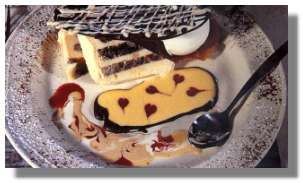
A Taste of Scotland
- From Clootie Dumplings to Loch Fyne Oysters

Origins of "A Taste of Scotland"
For over twenty years A Taste of Scotland has been committed to the improvement of Scottish food and drink. The organisation began as an initiative of the Scottish Tourist Board. Their aim and objective is to offer advice and encouragement, promoting the importance of serving fresh local produce and awarding hotels and restaurants for first class and imaginative cuisine. By visiting many a city restaurant, country house hotel, or village pub today, the high quality and choice of menus clearly indicates a major change in Scottish hospitality up an down the land. A Taste of Scotland has succeeded in leaps and bounds in recent years in the improvement in standards, inspiring cooks and chefs to be creative in the kitchen with an emphasis on the best Scottish ingredients, fish, game, vegetables, fruit and cheese.Amanda Clark has been Chief Executive for the past eight years and seems to be the perfect person for the job: she is passionate about good food and finding great places to eat and drink in Scotland is very much part of her philosophy, both on a professional basis and in her own spare time. She is dedicated to developing the valuable work of A Taste of Scotland in passing on their message far and wide, from Port Patrick in Dumfries and Galloway to the Shetland Islands. Good simple, Scottish food plays a crucial role in the overall pleasure and experience of travelling about the country, for Scots at home and visitors alike. What could be a better image for tourism than people taking away with them, (together with their photographs of the unspoilt landscape), memories of hearty breakfasts, a delicious pub lunch, superb dinners, fine wines, beer and spirits, served with the warm smile of traditional Scottish hospitality.
The Changing Face of Scottish Food
The mystique which surrounds the traditional food of Scotland no doubt resides as much in the wonderful if somewhat obscure vocabulary involved, as in the intrinsic fascination of clootie dumplings (suet pudding steamed in a cloth), Selkirk bannocks (fruit buns), Cullen skink (smoked haddock soup) and haggis. Traditional Scottish cooking is hearty and sustaining, based on Scotland's plentiful supplies of fish and meat, supplemented by simple ingredients such as potatoes, barley and oatmeal. In fact such is the preponderance of oatmeal based foods, such as porridge and oatcakes that in the 18th century, Dr. Samuel Johnson was moved to include a definition of oats in his dictionary as the grain that supported horses in England but the people of Scotland.
Of Scottish culinary inventions, the much maligned haggis must be the most famous. A sheep's stomach stuffed with minced offal, oatmeal and suet, haggis is the focal point of Burns' Night celebrations. Laid proudly on a silver salver, it is piped in with great ceremony, eulogised in Burns' "Address to the Haggis" and then stabbed open with a dirk. Traditionally preceded by cock-a-leekie soup, the haggis is accompanied by bashed neeps and chappit tatties (mashed turnips and potatoes) and, of course, plenty of whisky.
The fish and shellfish, game and meat with which Scotland abounds are quite exceptional and in many cases renowned worldwide. Loch Fyne oysters and kippers, smoked salmon and Arbroath Smokies are outstanding quality, and exported daily around the world. Grouse is treated with esteem and borders on the reverential and beef from native Scottish breeds such as Aberdeen Angus is considered by many to be unsurpassed in flavour. Local lamb is held in similar high regard, the term gigot for the leg being a legacy of Scotland's Auld Alliance with France.
The Scots have traditionally had a notoriously sweet tooth and classic Scottish puddings and baking are generally of the wicked and calorific variety. Shortbread and Dundee Cake are served for afternoon tea, while puddings like cranachan, based on oatmeal with the inspired addition of whisky, cream, sugar and fresh fruit.
Today, Scottish chefs have established a new tradition which recognises Scotland's culinary heritage and fine local larder. Fresh game, seafood, vegetables and fruit are now often prepared with a lighter, inventive and contemporary touch. The blossoming of numerous city centre restaurants is significant, with young up and coming chefs experimenting in an international/Scottish fusion style of cooking, and particularly noteworthy are the kitchens of many of the smaller country house hotels in which Scotland and her visitors delight, many of which would readily withstand comparison with the grand restaurants of Europe and the USA.
If there is strong culinary renaissance taking place in the kitchen, this is being matched by the gradual change in Scots diet and taste. The traditional meat and two veg, chips (French fries) with everything and a roast on Sunday may still be there in many a household, but are being balanced by more varied and imaginative meals. There are differences across the generation gap, but the past couple of decades have brought the opportunity to travel, supermarkets offer a abundance of exotic international cuisine, celebrity chefs on television tying in with best selling recipe books, and restaurants, bistros and wine bars on every high street enticing people to enjoy a good night out.
People's expectations of standards have risen enormously in recent years and if they are going to pay to eat out, they want quality and value for money. For visitors to Scotland, especially from the United States and across Continental Europe, where fresh foods, fine dining and great service is the name of the game, this is very much a priority. This is where A Taste of Scotland's role comes into play, with their promotion and recommendation of the best places to eat and stay around Scotland.
Next page > A Guide to The Taste of Scotland Guide > Page 1, 2, 3.
Where else would you like to go in Scotland?

